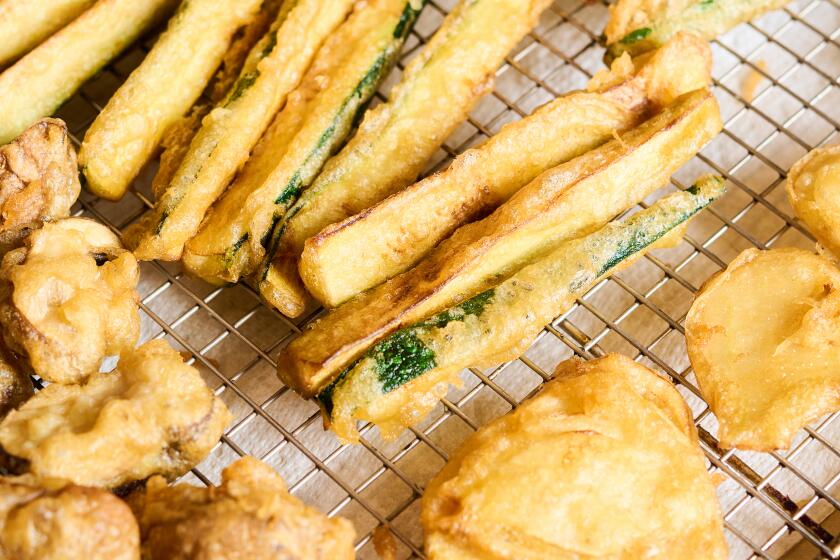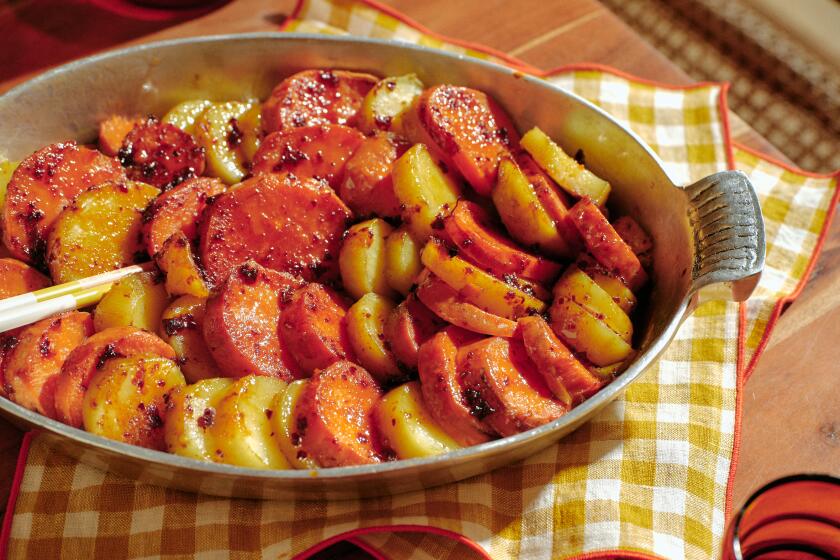Grilled radicchio and prosciutto
Do you remember the first time you saw the word “radicchio”? The first time you tried to say it out loud?
Now, how about the first time you cooked it? We didn’t think so. Radicchio may have gone from an obscure Italian vegetable to a supermarket familiarity, but for most people it remains nothing more than a splashy colored lettuce, a bit of crimson to break up the monotony of a pale green salad mix.
In Italy, particularly around Venice, it is cooked almost as often as it is served raw. It is grilled and sauteed, used in risotto and pasta, spread on pizza and folded into pastries. There is even a radicchio cookbook with 600 recipes.
Here, that seems like a funny idea: Cook lettuce?
Plainly, Lucio Gomiero still has a lot to do. Gomiero is the radicchio king: the world’s largest grower of the red-headed chicory and its tireless missionary. In the last decade his Salinas-based firm, European Vegetable Specialties, has gone from what might have seemed like a harebrained stunt to selling more than 10 million pounds of radicchio a year. He even exports it to Italy. But more than half of his harvest winds up chopped into pieces and thrown into bagged salad mixes, just to provide a little color.
“They could just as easily use flowers,” Gomiero says mournfully.
Radicchio is one of those definite Italian tastes, a combination of bitter and sweet that you just don’t find in other cuisines. It takes a little getting used to, but once you’ve bitten, you’ll have a hard time letting go.
Gomiero, 49, didn’t set out to be the radicchio king. After graduating from the University of Venice with a degree in architecture and going to work in his family’s construction firm, he got the winemaking bug.
So, almost as a hobby, in 1980 he started a small winery in the Euganean hills just south of his hometown of Padua. This area is not particularly known for fine wine, but his Vignalta “Gemola” has won the Tre Bicchieri, Italy’s highest wine honor, four years in a row. (And just as he’s brought radicchio to America, he’s planted the distinctly American grapes Petite Syrah and Zinfandel in the Veneto.)
Gomiero got into radicchio almost by accident. One of his construction co-workers was Carlo Boscolo, and, thrown together on a long project, the two became friends. Then Boscolo returned to his family’s business in Chioggia: The Boscolos are the largest growers of radicchio in Italy.
The two continued to get together for dinner every once in a while. One night in 1987, Boscolo asked a surprising question: Had Gomiero ever thought about going to America?
“He had started getting some interest from America about importing radicchio,” Gomiero says. “But he didn’t think it made sense to ship radicchio to America when you could probably grow it there.”
The adventure was not without missteps. Knowing little about agriculture in this country, they sent faxes to various U.S. offices of the Italian Trade Commission asking about growing areas. The only one that responded was in Atlanta, so their first American radicchio field was planted in 1987 in swampy south Georgia.
“We had never seen a pickup truck,” says Gomiero. “Or an alligator.”
The next year, they decided Salinas -- the famed Salad Bowl of America -- seemed like a more suitable location. They begged an appointment with an agricultural extension agent and quickly won him over.
There were still more hurdles. Unfamiliar with Salinas, they initially asked for 20 acres of prime growing area -- the farming equivalent of Bel-Air -- for their test plot. After the laughing stopped, they got one acre. It was enough.
“When the crop came in, we got $25 a box for radicchio when iceberg lettuce was getting $5,” Gomiero says. “Suddenly everybody got very euphoric about radicchio.”
Soon Gomiero and Boscolo teamed up with local growers John Tamagni and Dennis Johnson, who had already been experimenting with radicchio. They incorporated as European Vegetable Specialties in 1993.
A red carpet
Radicchio took to Salinas like a native, even preferring the loose soil of the cheaper land south of town to the high-priced, rich loam where most lettuces grow. Now, on the 10-mile drive from Salinas south to Chualar, there is field after field of radicchio.
“The uniqueness of this valley is that we don’t have a hot summer. The fog and the breezes from the ocean mitigate the temperature,” says Gomiero. “Radicchio doesn’t like the heat, so this place is heaven for radicchio in the summer. In the winter it’s no problem to grow it anyplace.”
Of course, if growing good radicchio were that easy, it would have been done before. The real secret to the company’s success is Boscolo’s seed selection.
“Carlo is really the radicchio guru,” Gomiero says. In America, most farmers buy seeds from suppliers who sell standardized strains. In Italy, it is far more common for farmers to collect seeds from their plants at the end of the growing season. Subtle variations occur, and the seeds from the best plants are kept to use the next year. Because of this, each family farm has its own strain of seeds specially suited for a particular soil and climate.
With his family’s history in the radicchio business, Boscolo has access to hundreds of different types of seeds. After a decade of testing, EVS has settled on seven strains of Chioggia radicchio for growing in the spring and summer, two in the fall and two more in the winter.
In addition to Chioggia, the company grows Castelfranco and Treviso radicchios. Chioggia and Castelfranco are round-headed and best for salads. Treviso is shaped more like romaine and adapts well to cooking.
Thriving in new soil
Like his beloved radicchio, Gomiero has transplanted well, though he remains Italian at the core. At his large, comfortable home in the hills above Salinas, the Italian satellite television station plays almost constantly. His wife, Katia, is still most at home speaking Italian, but his three kids -- son Giacomo and teenage daughters Giulia and Camilla -- seem thoroughly American.
In this family, it’s an easy mix. On consecutive weeknights, the Gomieros treat a visitor to long multi-course meals, each served with several wines. The kids come and go from the table as they please. The conversation ranges from radicchio to the girls’ roller-skating competition in Las Vegas to wine -- always wine.
In addition to Vignalta, Gomiero owns part of a new Brunello di Montalcino producer called La Fiorita, which just earned a rave review from critic Steve Tanzer. He also advises the Monterey winery De Tierra and serves as an unofficial consultant to what seems like half the home wineries in the Monterey area.
“Is dinner always like this?” Camilla is asked.
“Dad does love to cook,” she replies, with a sweetly forgiving adolescent sigh.
The next day, winding through the hills between growing areas in his radicchio-red Mercedes SUV, Gomiero reflects on his two countries.
“I like it that it’s very rational here,” Gomiero says. “In Italy, the way things are is that you can only do what is expressly permitted. In America, it’s the opposite: You can do anything that is not expressly forbidden. So I guess one way to look at it is I have the opportunity to live in two beautiful countries at the same time.”
Still, you can’t help but feel that his happiness will be complete only when Americans learn to love radicchio the way he does. Back at the EVS office, located in a row of traditional vegetable companies on the outskirts of Salinas, he and company President Dennis Donohue plot how to do that.
“We’ve gone from being a California-based grower and shipper to supplying radicchio around the world on a year-round basis,” says Donohue, a respected produce marketer even before he came to EVS seven years ago.
But being No. 1 has its complications. “It’s a tough world we’re in,” says Donohue. “Processors can never miss an order. They are also very sharp on price and ... deliveries.”
As a result, the company has about 3,000 acres of radicchio scattered all over the world. In addition to the Salinas area, EVS has significant plantings in Oxnard and near the Central Valley town of Blackwell in California; in Phoenix; and in Belle Glade, Fla., as well as in Okinawa and Montreal.
Being this spread out ensures that a weather disaster doesn’t wipe out the business. “We like to say that now we’re California-based and globally hedged,” Donohue says.
Indeed, one of the company’s biggest customers is Japan, to which EVS supplies up to 100,000 pounds a week. In fact, the Japanese get the very best radicchio EVS grows; they demand it and are willing to pay a hefty premium for it. Being sticklers for authenticity, they also cook with it.
It’s at home that Gomiero faces his toughest battle: convincing the salad eaters that this is one leaf that is every bit as good grilled as it is raw.
He listens patiently while Donohue discusses the intricacies of mass marketing, but you get the feeling he wishes for a simpler solution. If only every American could come to his house and taste a bite of risotto with radicchio, pasta with radicchio or maybe Katia’s special strudel with radicchio, then they would see the light.
Heat a grill or grill pan on high heat and brush with oil.
Trim the ends of the radicchio and cut lengthwise into quarters. Brush the cut sides with the remaining oil and place on the grill. Cook 1 to 2 minutes per side, turning, for about 5 minutes. The radicchio will be soft and wilted. Season with salt and immediately take 1 piece of prosciutto and wrap diagonally around each piece of radicchio. Serve immediately.
Get our Cooking newsletter.
Your roundup of inspiring recipes and kitchen tricks.
You may occasionally receive promotional content from the Los Angeles Times.















